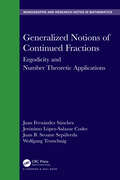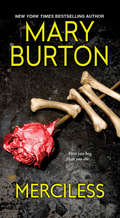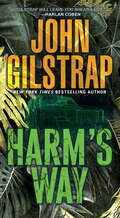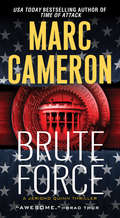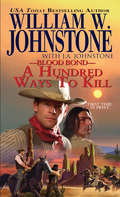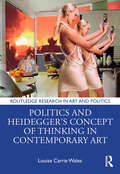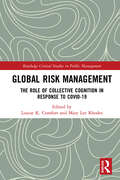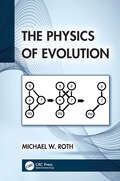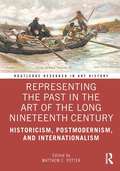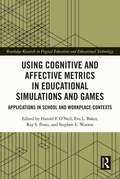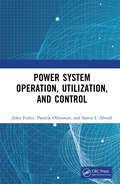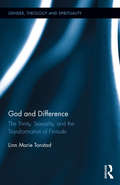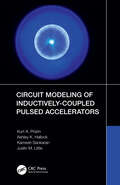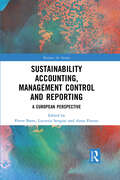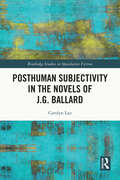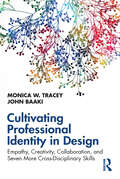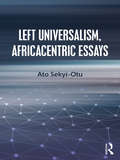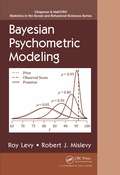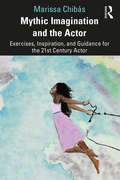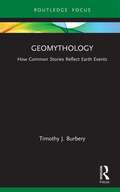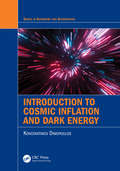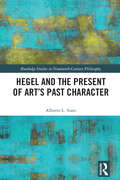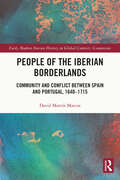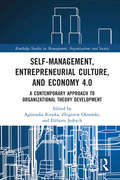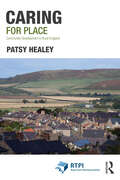- Table View
- List View
Generalized Notions of Continued Fractions: Ergodicity and Number Theoretic Applications (Chapman & Hall/CRC Monographs and Research Notes in Mathematics)
by Juan Fernández Sánchez Jerónimo López-Salazar Codes Juan B. Seoane Sepúlveda Wolfgang TrutschnigAncient times witnessed the origins of the theory of continued fractions. Throughout time, mathematical geniuses such as Euclid, Aryabhata, Fibonacci, Bombelli, Wallis, Huygens, or Euler have made significant contributions to the development of this famous theory, and it continues to evolve today, especially as a means of linking different areas of mathematics.This book, whose primary audience is graduate students and senior researchers, is motivated by the fascinating interrelations between ergodic theory and number theory (as established since the 1950s). It examines several generalizations and extensions of classical continued fractions, including generalized Lehner, simple, and Hirzebruch-Jung continued fractions. After deriving invariant ergodic measures for each of the underlying transformations on [0,1] it is shown that any of the famous formulas, going back to Khintchine and Levy, carry over to more general settings. Complementing these results, the entropy of the transformations is calculated and the natural extensions of the dynamical systems to [0,1]2 are analyzed. Features Suitable for graduate students and senior researchers Written by international senior experts in number theory Contains the basic background, including some elementary results, that the reader may need to know before hand, making it a self-contained volume
Merciless (Senseless Duo #2)
by Mary BurtonThe New York Times bestselling author&’s &“latest romantic suspense has it all—terrific plot, complex and engaging protagonists, a twisted villain&” (Erica Spindler). No Pity Each skeleton is flawless—gleaming white and perfectly preserved, a testament to his skill. Every scrap of flesh has been removed to reveal the glistening bone beneath. And the collection is growing . . . No Compassion When bleached human bones are identified as belonging to a former patient of Dr. James Dixon, Detective Malcolm Kier suspects the worst. Dixon was recently acquitted of attempted murder, thanks to defense attorney Angie Carlson. But as the body count rises, Kier is convinced that Angie is now the target of a brutal, brilliant psychopath. No Escape Angie is no stranger to the dark side of human nature. But nothing has prepared her for the decades-long legacy of madness and murder about to be revealed—or a killer ready to claim her as his ultimate trophy . . . &“Terrifying . . . this chilling thriller is an engrossing story.&” —Library Journal &“[A] feverish sequel to Senseless . . . convincing detective lingo and an appropriately shivery murder venue go a long way.&”—Publishers WeeklyPraise for the novels of Mary Burton &“Absolutely chilling.&”—Brenda Novak &“A twisted tale . . . I couldn't put it down!&”—Lisa Jackson &“Taut, compelling . . . delivers a page-turner.&”—Carla Neggers &“A chilling thriller.&”—Beverly Barton
Harm's Way (A Jonathan Grave Thriller #15)
by John GilstrapThe exhilarating new thriller from the New York Times and USA Today bestselling author takes readers on an action-packed thrill ride across rural Venezuela. The kidnappers are ruthless. The stakes are high. The odds are impossible. There&’s no way Jonathan Grave can say no… &“[Gilstrap&’s] greatest strength is the ability to blend breathtaking action with deep emotion regarding the characters.&” —Jeffery Deaver Henchmen of a vicious drug syndicate have snatched ten missionaries in a remote area of Venezuela and are holding them for ransom. The high-priority rescue op comes as a personal plea from FBI Director Irene Rivers, who has a very special interest in one of the hostages. The mission is strictly off the books, and there can be no international incident. Just get in and get out—and keep the precious cargo safe. With his key operatives Gunslinger and Boxers, Grave infiltrates the enemy camp. Right away, the rescue mission morphs into something far more dangerous—not just to Jonathan and his team, but to the whole world.&“I read HARM&’S WAY in one sitting, including through dinner. Loved the book! John Gilstrap fast became one of my favorite authors. I look forward to many more good reads like this one.&” –Fern Michaels
Brute Force (A Jericho Quinn Thriller #6)
by Marc CameronAre these the last days of America? A thriller starring &“a compelling, never-give-an-inch hero who will appeal to Jack Reacher fans&” (Booklist). In the aftermath of a devastating biological attack, America stands on the brink of disaster. The President of the United States is controlled by terrorists. The Vice President, global mastermind Lee McKeon, is plotting his next move. And special agent Jericho Quinn is running for his life. Desperate to clear his name—and expose the conspirators in the White House—Quinn must race against time before McKeon can execute his evil plan. It begins with heightened security, mass surveillance, and the establishment of a brutal police state. It can only end in the takeover of America. The only thing standing between democracy and destruction is a man named Quinn…and one perfectly aimed bullet. From the New York Times-bestselling author of Tom Clancy Oath of Office, this heart-pounding thriller features &“a formidable warrior readers will want to see more of&” (Publishers Weekly).
A Hundred Ways to Kill: A Hundred Ways to Kill (Blood Bond #16)
by William W. Johnstone J.A. JohnstoneThese blood brothers are gunslingers with a conscience—and red-hot lead. Sharp-shooting adventure from the greatest Western writers of the 21st century. Young Matt Bodine and Sam Two Wolves became blood brothers on the day the rancher&’s son saved the warrior&’s life, forging a bond no one could ever break. And as years passed, a legend grew of the Cheyenne and the white man who rode together—and who could jerk killing iron with the best of them . . . A Hundred Ways to Kill Heading west to San Diego some honest pilgrims pay good money to keep their wagon train safe, but their guards soon turn against their charges and head off to Mexico with six young girls captive. When word reaches Tombstone—where Matt Bodine and Sam Two Wolves are wearing out their welcome gambling with Wyatt Earp—they know they have to do something about it. But it&’s going to take more than their bravery and shooting skills to rescue those girls from the merciless white slavers. On the way to Mexico, Matt and Sam ride into a war party of Apaches. They&’ll be facing outlaws and furious Apaches at the same time. For two blood brothers, the idea is to rescue those girls and blast their way North to freedom—no matter how many bullets it takes, or how many guns are shooting back . . . Praise for the novels of William W. Johnstone &“[A] rousing, two-fisted saga of the growing American frontier.&”—Publishers Weekly on Eyes of Eagles &“There&’s plenty of gunplay and fast-paced action.&”—Curled Up with a Good Book on Dead Before Sundown
Politics and Heidegger’s Concept of Thinking in Contemporary Art (Routledge Research in Art and Politics)
by Louise Carrie WalesResponding to Heidegger’s stark warnings concerning the essence of technology, this book demonstrates art’s capacity to emancipate the life-world from globalized technological enframing. Louise Carrie Wales presents the work of five contemporary artists – Martha Rosler, Christian Boltanski, Krzysztof Wodiczko, and collaborators Noorafshan Mirza and Brad Butler – who challenge our thinking and compel a dramatic re-positioning of social norms and hidden beliefs. The through-line is rooted in Heidegger’s question posed at the conclusion of his technology essay as understood through artworks that provides a counter to enframing while using increasingly sophisticated technological methods. The themes are political in nature and continue to have profound resonance in today’s geopolitical climate. The book will be of interest to scholars working in art history, aesthetics, philosophy, and visual culture.
Global Risk Management: The Role of Collective Cognition in Response to COVID-19 (ISSN)
by Louise K. Comfort Mary Lee RhodesThe rise and spread of Covid-19 in the beginning of 2020 presents a once-in-a-century challenge and opportunity for decision makers, managers, scholars, and citizens to understand the risks, mitigate its impact and prepare for future crises. Drawing on a global network of scholars, this book presents a comparative analysis of ten nations’ response to a global pandemic, while operating nominally under the framework of the World Health Organization. The book introduces the concept of ‘collective cognition’ as an analytic lens for examining the nations’ response to Covid-19 during the first six months of the emerging pandemic (January – June 2020) and draws out insights for improving systems of global risk management. This book addresses four primary audiences: policy-makers and leaders in nations struggling to contain viruses while guiding their societies under threat; academic researchers, students, and educators engaged in preparing the next generation of professionals committed to investigating emerging risk: managers of non-profit and private organizations that operate and maintain the networks of social, technical, and economic services that are essential to functioning communities; and the informed general public interested in understanding this extraordinary sequence of events and in managing the novel risk of COVID-19 in a more informed, responsible way.
The Physics of Evolution
by Michael W. RothThis book provides an introduction to the significant role of physics in evolution, based on the ideas of matter and energy resource flow, organism self-copying, and ecological change. The text employs these ideas to create quantitative models for important evolutionary processes.Many fields of science and engineering have come up against the problem of complex design—when details become so numerous that computer power alone cannot make progress. Nature solved the complex-design problem using evolution, yet how it did so has been a mystery. Both laboratory experiments and computer-simulation attempts eventually stopped evolving. Something more than Darwin’s ideas of heredity, variation, and selection was needed. The solution is that there is a fourth element to evolution: ecological change. When a new variation is selected, this can change the ecology, and the new ecology can create new opportunities for even more new variations to be selected. Through this endless cycle, complexity can grow automatically. This book uses the physics of resource flow to describe this process in detail, developing quantitative models for many evolutionary processes, including selection, multicellularity, coevolution, sexual reproduction, and the Serengeti Rules. The text demonstrates that these models are in conceptual agreement with numerous examples of biological phenomena, and reveals, through physics, how complex design can arise naturally. This will serve as a key text on the part physics plays in evolution, and will be of great interest to students at the university level and above studying biophysics, physics, systems biology, and related fields.
Representing the Past in the Art of the Long Nineteenth Century: Historicism, Postmodernism, and Internationalism (Routledge Research in Art History)
by Matthew C. PotterThis edited collection explores the intersection of historical studies and the artistic representation of the past in the long nineteenth century. The case studies provide not just an account of the pursuit of history in art within Western Europe but also examples from beyond that sphere. These cover canonical and conventional examples of history painting as well as more inclusive, ‘popular’ and vernacular visual cultural phenomena. General themes explored include the problematics internal to the theory and practice of academic history painting and historical genre painting, including compositional devices and the authenticity of artefacts depicted; relationships of power and purpose in historical art; the use of historical art for alternative Liberal and authoritarian ideals; the international cross-fertilisation of ideas about historical art; and exploration of the diverse influences of socioeconomic and geopolitical factors. This book will be of particular interest to scholars of the histories of nineteenth-century art and culture.
Using Cognitive and Affective Metrics in Educational Simulations and Games: Applications in School and Workplace Contexts (Routledge Research in Digital Education and Educational Technology)
by Harold F. O'NeilPresenting original studies and rich conceptual analyses, this volume explores how cognitive and affective metrics can be used to effectively assess, modify, and enhance learning and assessment outcomes of simulations and games used in education and training.The volume responds to the increasing use of computer-based simulations and games across academic and professional sectors by bringing together contributions from different research communities, including K-12 and postsecondary education, medical, and military contexts. Drawing on empirical results, the chapter authors focus on the design and assessment of educational simulations and games. They describe how quantitative and qualitative metrics can be used effectively to evaluate and tailor instructional resources to the cognitive and affective needs of the individual learner. In doing so, the volume enhances understanding of how games and simulations can intersect with the science of learning to improve educational outcomes. Given its rigorous and multidisciplinary approach, this book will prove an indispensable resource for researchers and scholars in the fields of educational assessment and evaluation, educational technology, military psychology, and educational psychology.
Power System Operation, Utilization, and Control
by John Fuller Pamela Obiomon Samir I. AboodThis book presents power system analysis methods that cover all aspects of power systems operation, utilization, control, and system management.At the beginning of each chapter, an introduction is given describing the objectives of the chapter. The authors have attempted to present power system parameters in a lucid, logical, step-by-step approach in a lucid, logical, step-by-step approach.In recognition of requirements by the Accreditation Board for Engineering and Technology (ABET) on integration of engineering computer tools, the authors demonstrate the use of MATLAB® programming in obtaining solutions to engineering power problems. MATLAB is introduced in a student-friendly manner and follow up is given in Appendix A. The use of MATLAB and power system applications arepresented throughout the book.Practice problems immediately follow each illustrative example. Students can follow the example step-by-step to solve the practice problems. These practice problems test students’ comprehension and reinforce key concepts before moving on to the next chapter.In each chapter, the authors discuss some application aspects of the chapter's concepts using computer programming. The material covered in the chapter applied to at least one or two practical problems to help students see how the concepts are used in real-life situations.Thoroughly worked examples are provided at the end of every section. These examples give students a solid grasp of the solutions and the confidence to solve similar problems themselves.Designed for a three-hour semester course on Power System Operation, Utilization, and Control, this book is intended as a textbook for a senior-level undergraduate student in electrical and computer engineering. The prerequisites for a course based on this book are knowledge of standard mathematics, including calculus and complex numbers and basic undergraduate engineering courses.
God and Difference: The Trinity, Sexuality, and the Transformation of Finitude (ISSN)
by Linn Marie TonstadGod and Difference interlaces Christian theology with queer and feminist theory for both critical and constructive ends. Linn Marie Tonstad uses queer theory to show certain failures of Christian thinking about God, gender, and sexuality. She employs queer theory to dissect trinitarian discourse and the resonances found in contemporary Christian thought between sexual difference and difference within the trinity. Tonstad critiques a broad swath of prominent Christian theologians who either use queer theory in their work or affirm the validity of same-sex relationships, arguing that their work inadvertently promotes gendered hierarchy. This volume contributes to central debates in Christianity over divine and human personhood, gendered relationality, and the trinity, and provides original accounts of God, sexual difference, and Christian community that are both theologically rich and thoroughly queer.
Circuit Modeling of Inductively-Coupled Pulsed Accelerators
by Kurt A. Polzin Ashley K. Hallock Kamesh Sankaran Justin M. LittleThis monograph describes lumped-element modelling techniques for inductively-coupled pulsed accelerators, starting from the basic physical description of the various processes and then bringing all the pieces together into solutions. Coilguns, inductive pulsed plasma thrusters, and compact toroids have each been individually studied using the methods used in this monograph. This monograph is of interest to researchers and graduate students in physics, engineering, and mathematics presently studying inductively-coupled pulsed accelerators.Features The first book to unify the lumped-element modelling techniques for various inductively-coupled pulsed accelerator implementations. Discussion of modelling different accelerators in a coherent, rigorous manner, demonstrating the similarities and differences for each type. Authored by authorities in the field.
Sustainability Accounting, Management Control and Reporting: A European Perspective (Business for Society)
by Pierre BaretSustainability Accounting, Management Control and Reporting: A European Perspective traces a picture of innovative performance measurement tools and approaches to drive organizations to implement their shared value and sustainability strategy, considering different perspectives around accounting, managerial control and reporting. In recent years, organizations managing their responsible approach with relevance and pressure from stakeholders and regulations has proven to be a major challenge. During the first two decades of the 21st century, many companies have reached a real maturity in this area and have deployed coherent responsible approaches that are integrated into their overall strategy. It is now a matter of steering these responsible approaches from an accounting and managerial standpoint, but also of reporting on them. It requires the simultaneous use of comprehensive accounting, controlling and reporting tools. This book provides an innovative perspective on sustainable management control, comprehensive accounting and integrated reporting, presenting the most recent proposals and the main critical issues. Aimed at researchers, academics, managers, business leaders and advanced students, the book will be especially valuable to those in the fields of corporate social responsibility, strategic management, and accounting.
Posthuman Subjectivity in the Novels of J.G. Ballard (Routledge Studies in Speculative Fiction)
by Carolyn LauThis book proposes that Ballard’s novels extrapolate the formation of a posthuman subjectivity that is centred around an affirmative understanding of what a human body can do. This new subjectivity transforms constraints and prescribed desires into creative openings in a hyper-mediated control society that conditions docile bodies through technology and consumerism. Set in surrealist predicaments in postwar affluent Western societies, Ballard’s novels remind us of the fragile veneer of order in the familiar every day. In these moments of crisis, complacent characters are compelled to undergo a process of defamiliarisation and transformation of their understanding of the self and the body. The ability to form new relationships with the unfamiliar is imperative to survival in a hostile environment. Ballard delineates both the possibilities and obstacles of forming these relationships. In particular, the author attributes the failure to do so to the irreconcilable contradictions of late capitalism.
Cultivating Professional Identity in Design: Empathy, Creativity, Collaboration, and Seven More Cross-Disciplinary Skills
by Monica W. Tracey John BaakiCultivating Professional Identity in Design is a nuanced, comprehensive companion for designers across disciplines honing their identities, self-perception, personal strengths, and essential attributes. Designers’ identities, whether rooted in education, workforce training, digital technology, arts and graphics, built environment, or other fields, are always evolving, influenced by any combination of current mindset, concrete responsibilities, team dynamics, and more. Applicable to designers of all contexts, this inspiring yet rigorous book guides practitioners and students to progress with ten key traits: empathy, uncertainty, creativity, ethics, diversity/equity/inclusion, reflection, learning, communication, collaboration, and decision-making.Though it details a complete journey from start to finish, this book acknowledges the varying paths of designers’ roles and is structured for a flexible, highly iterative reading experience. Segments can be read individually or out of order and revisited for new insights. Current and future stages of development – education experience, early-career opportunities, mid-career accomplishments, and/or career transitions – are factored in without hierarchy. Specific takeaways, activities, and reflection exercises are intended to work across settings and levels of experience. Design hopefuls and experts alike will find a new way to participate in and persevere through their work.
Left Universalism, Africacentric Essays
by Ato Sekyi-OtuLeft Universalism, Africacentric Essays presents a defense of universalism as the foundation of moral and political arguments and commitments. Consisting of five intertwined essays, the book claims that centering such arguments and commitments on a particular place, in this instance the African world, is entirely compatible with that foundational universalism. Ato Sekyi-Otu thus proposes a less conventional mode of Africacentrism, one that rejects the usual hostility to universalism as an imperialist Eurocentric hoax. Sekyi-Otu argues that universalism is an inescapable presupposition of ethical judgment in general and critique in particular, and that it is especially indispensable for radical criticism of conditions of existence in postcolonial society and for vindicating visions of social regeneration. The constituent chapters of the book are exhibits of that argument and question some fashionable conceptual oppositions and value apartheids.This book will be of great interest to students and scholars in the fields of social and political philosophy, contemporary political theory, postcolonial studies, African philosophy and social thought.
Bayesian Psychometric Modeling (Chapman & Hall/CRC Statistics in the Social and Behavioral Sciences)
by Roy Levy Robert J. MislevyA Single Cohesive Framework of Tools and Procedures for Psychometrics and AssessmentBayesian Psychometric Modeling presents a unified Bayesian approach across traditionally separate families of psychometric models. It shows that Bayesian techniques, as alternatives to conventional approaches, offer distinct and profound advantages in achieving many goals of psychometrics.Adopting a Bayesian approach can aid in unifying seemingly disparate—and sometimes conflicting—ideas and activities in psychometrics. This book explains both how to perform psychometrics using Bayesian methods and why many of the activities in psychometrics align with Bayesian thinking.The first part of the book introduces foundational principles and statistical models, including conceptual issues, normal distribution models, Markov chain Monte Carlo estimation, and regression. Focusing more directly on psychometrics, the second part covers popular psychometric models, including classical test theory, factor analysis, item response theory, latent class analysis, and Bayesian networks. Throughout the book, procedures are illustrated using examples primarily from educational assessments. A supplementary website provides the datasets, WinBUGS code, R code, and Netica files used in the examples.
Mythic Imagination and the Actor: Exercises, Inspiration, and Guidance for the 21st Century Actor
by Marissa ChibásIn Mythic Imagination and the Actor, Marissa Chibás draws on over three decades of experience as a Latinx actor, writer, filmmaker, and teacher to offer an approach to acting that embraces collective imagination, archetypal work, and the mythic. The book begins with a comparative analysis between method acting and mythic acting, encouraging actors to push past the limits of singular life experience and move to a realm where imagination and metaphor thrive. In the context of mythic acting, the book explores awareness work, solo performance creation, the power of archetypes, character building exercises, creating a body/text connection, and how to be the detective of your own process. Through this inclusive guide for a new age of diverse performers traversing gender, ability, culture, and race, readers are able to move beyond their limits to a deep engagement with the infinite possibilities of rich imagination. The final chapter empowers and motivates artists to live healthfully within the practice and create a personal artistic vision plan.Written for actors and students of acting, American Drama, and film and theatre studies, Mythic Imagination and the Actor provides practical exercises and prompts to unlock and interpret an actor’s deepest creative sources.
Geomythology: How Common Stories Reflect Earth Events (Routledge Focus on Literature)
by Timothy J. BurberyGold-guarding griffins, Cyclopes, killer lakes, man-eating birds, and "fire devils" from the sky—such wonders have long been dismissed as fictional. Now, thanks to the richly interdisciplinary field of geomythology, researchers are taking a second look. It turns out that these and similar tales, which originated in pre-literate societies, contain surprisingly accurate, pre-scientific intuitions about startling or catastrophic earth-based phenomena such as volcanoes, earthquakes, tsunamis, and the unearthing of bizarre animal bones. Geomythology: How Common Stories Reflect Earth Events provides an accessible, engaging overview of this hybrid discipline. The introductory chapter surveys geomythology’s remarkable history and its core concepts, while the second and third chapters analyze the geomythical resonances of universal earth tales about dragons and giants. Chapter 4 narrows the focus to regional stories and discusses the ways these and other myths have influenced legends about griffins, Cyclopes, and other iconic creatures. The final chapter considers future avenues of research in geomythology, including geohazard management, geomythology databases, geomythical "cold cases," and ways the discipline might eventually set, rather than merely support, research agendas in science. Thus, the book constitutes a valuable asset for scientists and lay readers alike, particularly in a time of growing interest in monsters, massive climate change, and natural disasters.
Introduction to Cosmic Inflation and Dark Energy (ISSN)
by Konstantinos DimopoulosCosmic inflation and dark energy hold the key to the origin and the eventual fate of the Universe. Despite the increasing prominence of these subjects in research and teaching over the past decade or more, no introductory textbook dedicated to these topics has been previously published. Dr. Konstantinos Dimopoulos is a highly regarded expert in the field, and an experienced communicator of the subject to students. In this book, he provides advanced undergraduate and early graduate students with an accessible introduction and equips them with the tools they need to understand the cosmology of cosmic inflation and dark energy.Features: Provides a concise, pedagogical "crash course" in big bang cosmology, focusing on the dynamics and the history of the Universe, with an emphasis on the role of dark energy Chapters contain questions and problems for readers to test their understanding The first book to make cosmic inflation and dark energy accessible to students
Hegel and the Present of Art’s Past Character (Routledge Studies in Nineteenth-Century Philosophy)
by Alberto L. SianiThis book reclaims Hegel’s notion of the “end of art”—or, more precisely, of “art’s past character”—not just as a piece of the history of philosophy but as a living critical and interpretive methodology. It addresses the presence of the past character of art in both Hegel and contemporary philosophy and aesthetics. The book’s innovative contribution lies in unifying the Hegelian thesis with discussions of contemporary art and philosophy. The author not only offers a Hegelian exegesis but also applies the idea of the past character of art to themes that are related to both Hegel’s philosophy, such as the French Revolution and the modern state, Kantian aesthetics, and religion and the sacred space disclosed for art, and going beyond Hegel, such as Celan's poetry, Gramsci's criticism of Croce, human rights, and even the grunge rock band Pearl Jam. Conversely, such non-Hegelian explorations will help enlighten what may look like a specific thread of Hegel’s aesthetics, but can be used to shed light on some core motives of his philosophy. The author’s interpretation of art’s past character reclaims the full value, attractiveness, and philosophical soundness of Hegel’s thesis, while rejecting its interpretation in terms of a complete dissolution of the aesthetic element into the philosophical one. Hegel and the Present of Art’s Past Character will be of interest to scholars and advanced students working on Hegel, philosophy of art and aesthetics, history of philosophy, political philosophy, and art theory.
People of the Iberian Borderlands: Community and Conflict between Spain and Portugal, 1640–1715 (Early Modern Iberian History in Global Contexts)
by David Martín MarcosThis book is devoted to the inhabitants of the Spanish–Portuguese borderlands during the early modern period. It seeks to challenge a predominant historiography focused on the study of borderlands societies, relying exclusively on the antagonistic topics of subversion and the construction of boundaries. It states that by focusing just on one concept or another there is a restrictive understanding tending to condition the agency of local communities by external narratives. Thus, if traditionally border people were reduced by some scholars to actors of a struggle against a supposedly imposed border; in a more modern perspective, their behaviors have been also framed in bottom-up processes of consolidation of spaces of sovereignty in a no less limiting vision. Faced with both approaches, the objective of this work is not to deny them but, first and foremost, to situate the experiences of border populations outside of logics that I understand as originally alien to themselves, and to highlight their own subjectivity. Finally, it also demonstrates that most of the practices developed by border people were fundamentally aimed at defending their local communities.It will be useful for both audiences interested in early modern Iberia or border studies from a bottom-up perspective.
Self-Management, Entrepreneurial Culture, and Economy 4.0: A Contemporary Approach to Organizational Theory Development (Routledge Studies in Management, Organizations and Society)
by Agnieszka RzepkaThis book offers practical insight into the changing ways in which organizations operate today. Building on a groundbreaking concept of teal organizations, the book illustrates the practicality of advocating a lack of hierarchy of predetermined positions and the introduction of roles that come with clear responsibilities constantly defined according to current needs. First described by Frederic Laloux, a teal organization is a ground-breaking approach to managing organizations that is being adopted around the world, which turns everyone into a leader. This new paradigm rests on the ideas of wholeness, evolutionary purpose, employee autonomy, and self-management based on peer relationships. Its main assumption is the empowerment of the employee resulting in a change in workplace relationships and a more soulful and purposeful work environment.Drawing on the authors’ research across six different countries, it presents the evolution of self-management and entrepreneurial culture in the current age of Economy 4.0 and examines how the teal concept has been implemented around the world. It examines misconceptions surrounding this novel approach and diagnoses the practical problems connected with implementing it in the current uncertain times. It will be of value to researchers, academics, managers, and students in the fields of management and organizational studies.
Caring for Place: Community Development in Rural England (ISSN)
by Patsy HealeyThis book draws on preeminent planning theorist Patsy Healey’s personal experiences as a resident of a small rural town in England, to explore what place and community mean in a particular context, and how different initiatives struggle to get a stake in the wider governance relations while maintaining their own focus and ways of working. Throughout the book, Healey assesses the public value generated by community initiatives and the impact of such activity on wider governance dynamics.Healey explores the power which small communities are able to mobilise through self-organisation and grassroots activism. Through the lens of Wooler and Glendale as a micro-society, the book centres on a community experiencing an economic and demographic transition. It focuses on three initiatives developed and led by local people – a small community development trust, an informal attentionmobilising network, and a Neighbourhood Plan project which uses an opportunity provided within the formal planning system. It examines how, in such civil society activism, people came together to promote local development in a place and community neglected by the dominant political economy.The book details the power and force of community initiative and its potential for transforming both the future possibilities for the place and community itself, as well as wider governance relations. Overall, it seeks to enrich academic and policy discussion about how the relations between formal government and civil society energy could evolve in more productive and progressive directions.
